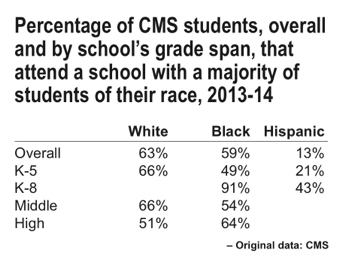June 16, 2014
In a school district in which no racial or ethnic group accounts for a majority of the students, more than half of Charlotte-Mecklenburg schools, and more than half of schools in each grade span, draw a majority of their students from one race.
CMS continues to be the district that made resegregation work.
 About a third of K-5 schools have a white majority. Another third have a black majority, while 7% of the K-5s have an Hispanic majority.
About a third of K-5 schools have a white majority. Another third have a black majority, while 7% of the K-5s have an Hispanic majority.
About four-fifths of the K-8s have a black majority. Eight of those K-8s are 80% or more black.
High school programs include not just the big regional high schools, but lots of small programs within them. By program, 54% of the programs now are majority-black, 14% majority-white.
By grade structure, 61 of 87 K-5s have a majority race; 13 of 14 K-8s; 18 of 27 middle schools; and 19 of 29 high school programs.
Of greater interest than the schoolhouses is the toll on individual children: that is, how many or what percentage of them are going to schools where public policy has led to them being sorted out so thoroughly by race.
The results are in the adjoining tables, based on the recent release of CMS demographic data for the 3rd month of the 2013-14 school year, which is here.
 Overall, 63% of white children attend majority-white schools; 59% of all CMS black children attend majority-black schools. Since there are only 8 majority-Hispanic schools, only 13% of Hispanic children attend majority-Hispanic schools.
Overall, 63% of white children attend majority-white schools; 59% of all CMS black children attend majority-black schools. Since there are only 8 majority-Hispanic schools, only 13% of Hispanic children attend majority-Hispanic schools.
So 34,677 of the 58,888 black students in CMS are in majority-black schools.
That’s because, when the school board succumbed to tribalism in 2002, it rewrote the legal system of school assignment to mostly mirror Mecklenburg’s racially and socio-economically segregated housing patterns. And that’s exactly what a lot of the board’s constituents demanded.
The achievement outcomes from this system are a topic for another day, but they are well known: The results clearly don’t work equally well for all tribes. Result? Equality under the law was thrown under the bus by the school board.
Is inequality under the law one of your cherished civic values? If not, have a chat with your school board members. An earlier generation depended on courts to intervene. This time, the solution may require electoral activism.
– Steve Johnston
